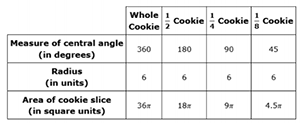Clusters should not be sorted from Major to Supporting and then taught in that order. To do so would strip the coherence of the mathematical ideas and miss the opportunity to enhance the major work of the grade with the supporting clusters.
- Assessment Limits :
The center of dilation must be given. - Calculator :
Neutral
- Clarification :
Students will use similarity to derive the fact that the length of the arc
intercepted by an angle is proportional to the radius, and define the
radian measure as the constant of proportionality.Students will apply similarity to solve problems that involve the
length of the arc intercepted by an angle and the radius of a circle.Students will derive the formula for the area of a sector.
Students will use the formula for the area of a sector to solve
problems. - Stimulus Attributes :
Items may be set in a real-world or mathematical context - Response Attributes :
Items may require the student to use or choose the correct unit of
measure.
- Test Item #: Sample Item 1
- Question:
Circle Q has a radius,r, in units. The measure of
 is xº, as shown.
is xº, as shown.A. Create an expression using r and x that can be used to find the length of
 , in units.
, in units.B. Then, create an expression that could be used to find the length of
 , in units, if circle Q were dilated by a scale factor of 3.7
, in units, if circle Q were dilated by a scale factor of 3.7 - Difficulty: N/A
- Type: EE: Equation Editor
- Test Item #: Sample Item 2
- Question:
Natasha's classmates have ordered her a cookie pizza for her birthday celebration. To share it among the class, they will be slicing the cookie into equal pieces. They want everyone to have an icing packet to add to his or her slice.
In order to approximate how much icing each person will need, they want to know the area of each slice of cookie. The following table lists the radius of the cookie pizza and the area of some of the possible divisions of the cookie.

This question has three parts.
Part A. What is the relationship between the area of a whole cookie with a radius of 6 units and the area of a portion whose central angle measures k degrees?
Part B. Using the information in the table, click on the blank to complete the equation for finding the area of a portion of a cookie with a radius of 6 units when given the measure of a central angle, in degrees, of the portion.
Part C. Click on the blank to complete the formula that can be used to find the area of any portion of a circle with radius w and a central angle of z degrees.
- Difficulty: N/A
- Type: : Multiple Types
Related Courses
Related Access Points
Related Resources
Formative Assessments
Lesson Plans
Problem-Solving Tasks
Text Resource
Tutorial
MFAS Formative Assessments
Students are asked to explain why the length of an arc intercepted by an angle is proportional to the radius and then explain how that proportionality leads to a definition of the radian measure of an angle.
Students are asked to write a formula to find the area of a sector of a circle and then explain and justify that formula.
Student Resources
Problem-Solving Tasks
This task combines two skills: making use of the relationship between a tangent segment to a circle and the radius touching that tangent segment, and computing lengths of circular arcs given the radii and central angles.
Type: Problem-Solving Task
This modeling task involves several different types of geometric knowledge and problem-solving: finding areas of sectors of circles, using trigonometric ratios to solve right triangles, and decomposing a complicated figure involving multiple circular arcs into parts whose areas can be found.
Type: Problem-Solving Task
Parent Resources
Problem-Solving Tasks
This task combines two skills: making use of the relationship between a tangent segment to a circle and the radius touching that tangent segment, and computing lengths of circular arcs given the radii and central angles.
Type: Problem-Solving Task
This modeling task involves several different types of geometric knowledge and problem-solving: finding areas of sectors of circles, using trigonometric ratios to solve right triangles, and decomposing a complicated figure involving multiple circular arcs into parts whose areas can be found.
Type: Problem-Solving Task









